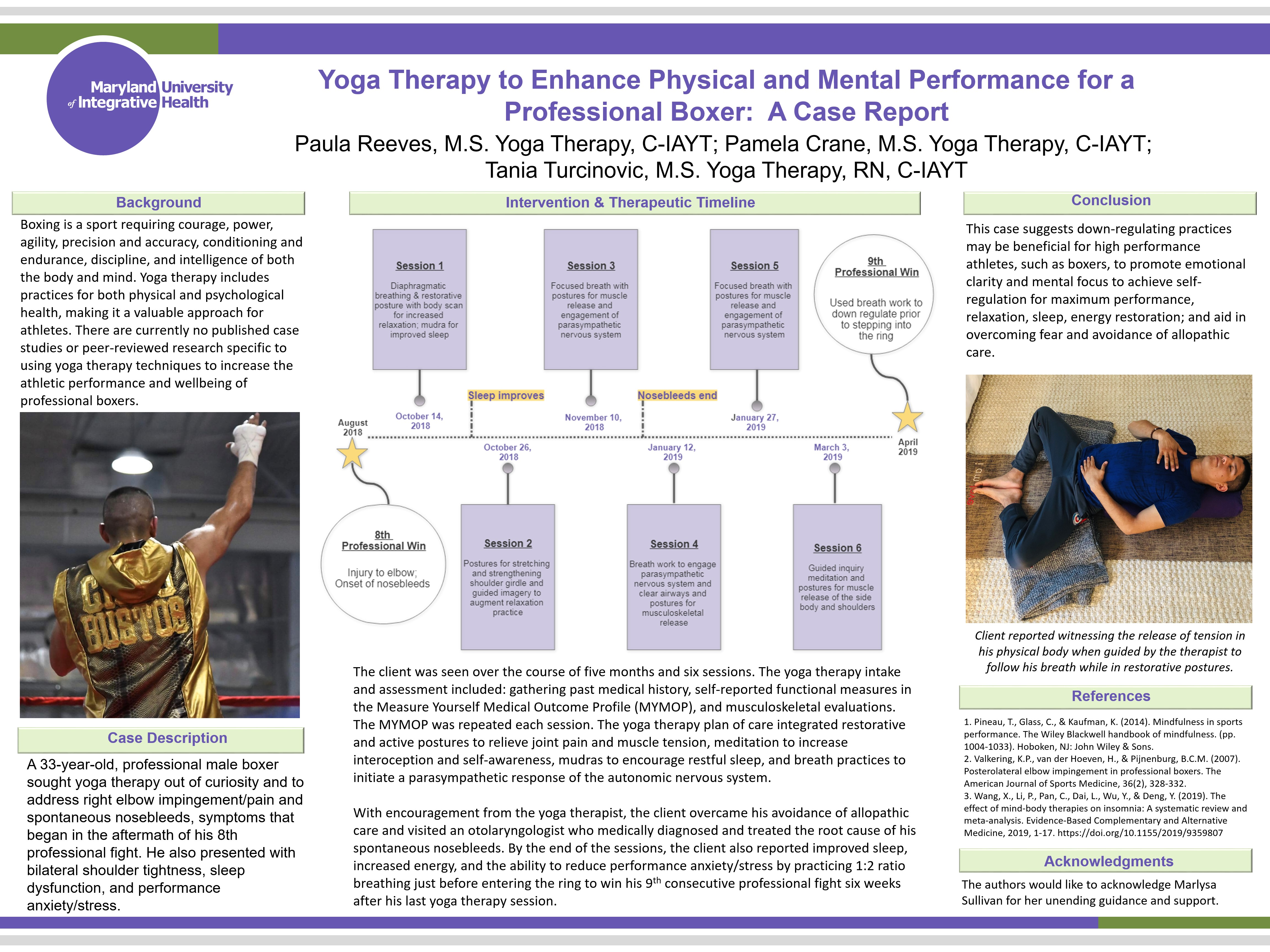Yoga Therapy to Enhance Physical and Mental Performance for a Professional Boxer: A Case Report Abstract
Author: Paula Reeves, MS Yoga Therapy, C-IAYT
Co-Authors: Pamela Crane, M.S. Yoga Therapy, C-IAYT; Tania Turcinovic, M.S. Yoga Therapy, RN, C-IAYT
Background: Boxing is a sport requiring courage, power, agility, precision and accuracy, conditioning and endurance, discipline, and intelligence of both the body and mind. Yoga therapy includes practices for both physical and psychological health, making it a valuable approach for athletes. There are currently no published case studies or peer-reviewed research specific to using yoga therapy techniques to increase the athletic performance and wellbeing of professional boxers.
Case Description: A 33-year-old, professional male boxer sought yoga therapy out of curiosity and to address right elbow impingement/pain and spontaneous nosebleeds, symptoms that began in the aftermath of his 8th professional fight. He also presented with bilateral shoulder tightness, sleep dysfunction, and performance anxiety/stress.
Intervention & Therapeutic Timeline: The client was seen over the course of five months and six sessions. The yoga therapy intake and assessment included: gathering past medical history, self-reported functional measures in the Measure Yourself Medical Outcome Profile (MYMOP), and musculoskeletal evaluations. The MYMOP was repeated each session. The yoga therapy plan of care integrated restorative and active postures to relieve joint pain and muscle tension, meditation to increase interoception and self-awareness, mudras to encourage restful sleep, and breath practices to initiate a parasympathetic response of the autonomic nervous system.
With encouragement from the yoga therapist, the client overcame his avoidance of allopathic care and visited an otolaryngologist who medically diagnosed and treated the root cause of his spontaneous nosebleeds. By the end of the sessions, the client also reported improved sleep, increased energy, and the ability to reduce performance anxiety/stress by practicing 1:2 ratio breathing just before entering the ring to win his 9th consecutive professional fight six weeks after his last yoga therapy session.
Conclusion:This case suggests down-regulating practices may be beneficial for high performance athletes, such as boxers, to promote emotional clarity and mental focus to achieve self-regulation for maximum performance, relaxation, sleep, energy restoration; and aid in overcoming fear and avoidance of allopathic care.
References: 1. Pineau, T., Glass, C., & Kaufman, K. (2014). Mindfulness in sports performance. The Wiley Blackwell handbook of mindfulness. (pp. 1004-1033). Hoboken, NJ: John Wiley & Sons.
2. Valkering, K.P., van der Hoeven, H., & Pijnenburg, B.C.M. (2007). Posterolateral elbow impingement in professional boxers. The American Journal of Sports Medicine, 36(2), 328-332.
3. Wang, X., Li, P., Pan, C., Dai, L., Wu, Y., & Deng, Y. (2019). The effect of mind-body therapies on insomnia: A systematic review and meta-analysis. Evidence-Based Complementary and Alternative Medicine, 2019, 1-17. https://doi.org/10.1155/2019/9359807
Acknowledgments: The authors would like to acknowledge Marlysa Sullivan for her unending guidance and support.
The poster and abstract featured here was accepted by and presented at the 2019 Symposium on Yoga Research (SYR) held at Kripalu Center for Yoga and Health in Stockbridge, Massachusetts.



Recent Comments